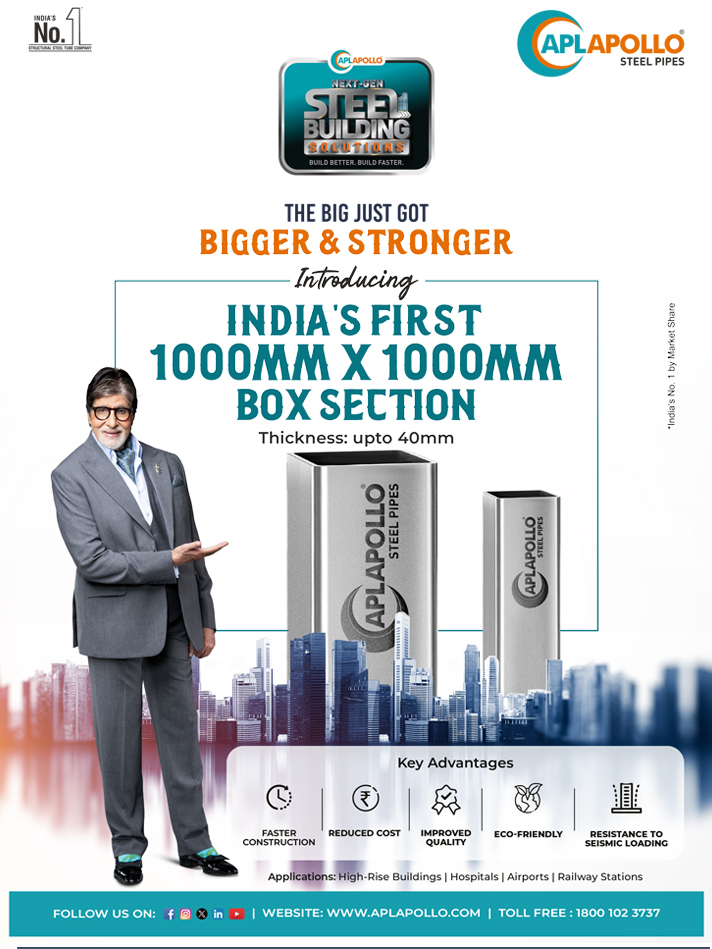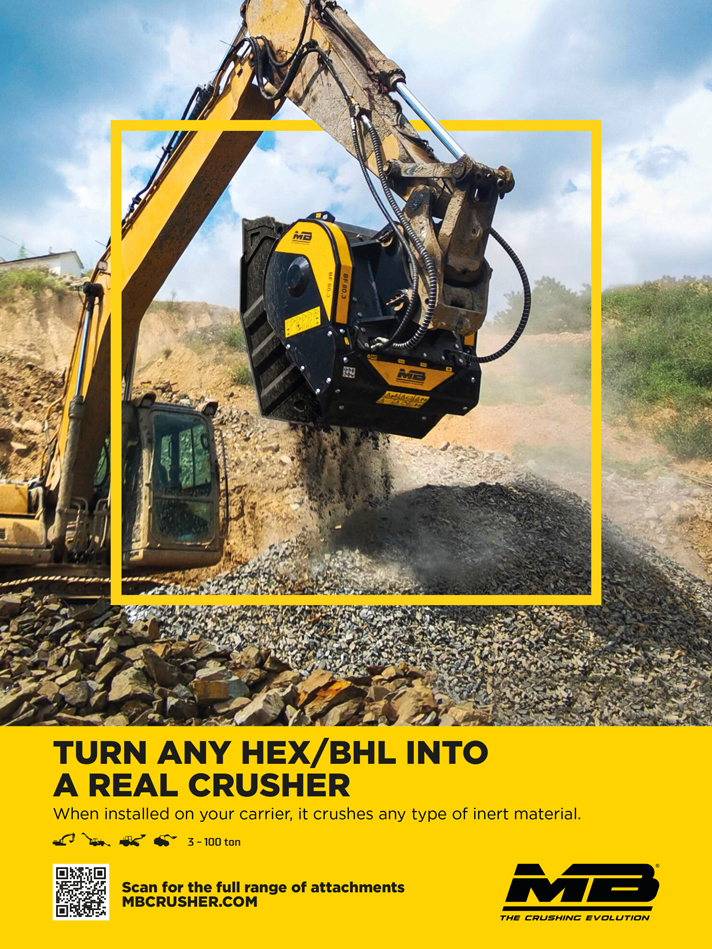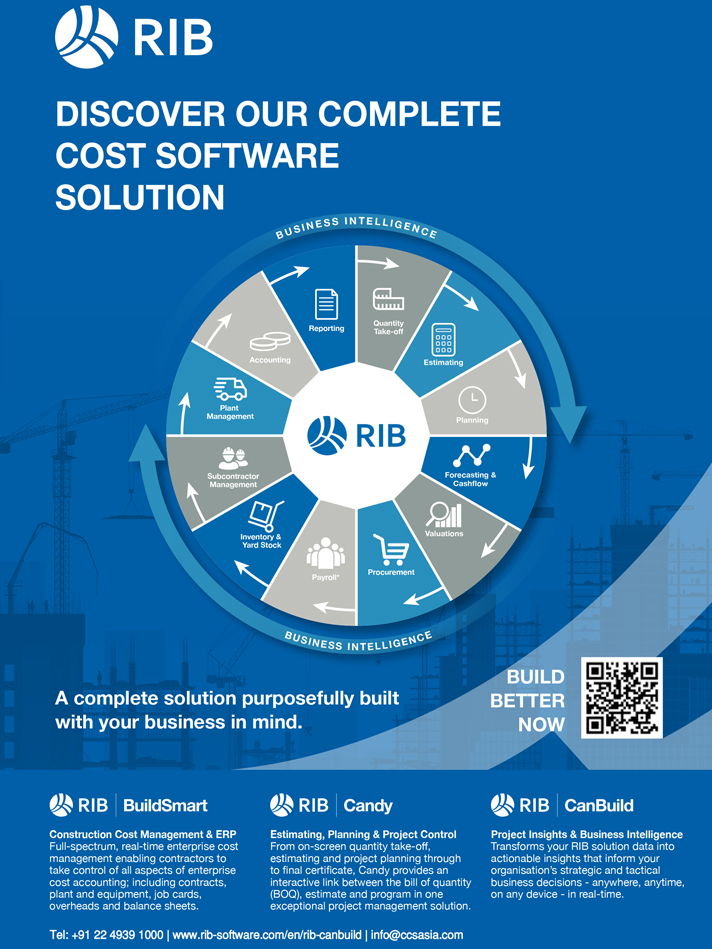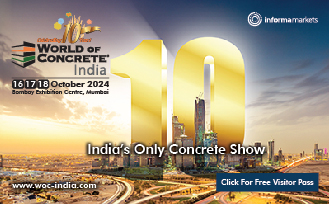
New Age Roofing Solutions
Commanding 3Cs – Safer, Smarter & Sustainable
A leading research states that the global roofing market is valued at US$ 82.2 billion in 2023 and is forecasted to expand at a CAGR of 5.5% from 2023 to 2033, while the Indian roofing market is projected to record a CAGR of 6% in the near future. India’s roofing industry is gearing up for the next wave of big projects, owing to a sustained growth in the infrastructure and industrial segments. Looking at this expanding horizon, roofing companies in India are working towards offering 3Cs to its customers – Smarter, Safer and Sustainable roofing solutions. Here’s tracking exciting journey of fast shaping up sophisticated roofing solutions that are slated to extend a structure’s total lifespan…
writes PRERNA SHARMA.
Roofs hold critical importance in any building be it commercial or residential, owing to the strong need for safety and security of the structure. The materials used to construct the roofs of homes and commercial structures including offices, hotels, and educational institutions include asphalt shingles, metal, elastomeric, roofing tiles, modified bitumen, and plastic. According to imarc, a shift in consumer preferences from conventional roofing materials towards reliable product variants on account of inflating income levels represents one of the major factors bolstering the market growth in India. Moreover, polycarbonate roofing sheets are gaining traction as they are easy to install in industrial and large-scale commercial buildings, weather-resistant, and available in various textures and designs with low maintenance costs. They are also utilized in sky lighting, swimming pools, walkways, and display signboards. Apart from this, the emerging trend of clear roofing panels in patios, sunrooms, and places that need natural light through the roof is contributing to market growth. These panels contain protective film layers that filter out harmful ultraviolet (UV) sun rays. Furthermore, as corrugated roofing sheets are strong, durable, and eco-friendly and offer reliable utility and enhanced strength, they are finding extensive applications in the agriculture sector for protecting garages, porches, and sheds. The expansion of the agriculture sector in the country on account of the rising population and surging food requirements is influencing the market positively. Additionally, the emerging green building concept is increasing public awareness about climate change, which is catalyzing the demand for zinc-aluminum coated sheets that provide excellent atmospheric resistance.
Demand for roofing products is also increasing as a result of technological improvements including eco-friendly roofing materials, green roofing, and drones for roof inspections.
Another research by EMR pointed out that metal roofs are likely to account for a significant share in the market. The metal roofs are witnessing increased demand as they provide resistance to fire and imparts strength and durability to the structure due to their superior quality. The increasing inclination of builders towards metal roofs is expected to propel the demand for the material, thus aiding the overall market growth. As metal roofs can lower energy consumption, can be recycled, and reduce a home’s carbon footprint, the material is expected to be one of the most preferred components towards structuring a building in the coming years.
Widespread use of bituminous shingles:
One of the most popular and reasonably priced roofing material is bituminous. Shingles and plates are utilized in bituminous. These shingles are not only a more affordable option for roofing, but they also offer enhanced security. These are covered with asphalt, and then with colourful mineral granules, which help to protect them from the weather.
Depending on the local climate and their maintenance, bituminous shingle roofing typically lasts between 25-30 years and is available in various thicknesses and grades. Bituminous is a tough building material that can adapt to any environmental situation and survive even the toughest weather conditions without easily succumbing to wear & tear. These can even endure powerful winds.
Solar Roofs: Solar roofing is likely the fastest growing piece of the roofing industry, as homeowners are able to protect their wallets and environment by investing in an alternative form of energy. Solar shingles, or solar roof tiles, are made of slim photovoltaic (PV) sheets that overlay or replace existing shingles on a roof. They absorb sunlight and convert it into electricity, allowing homeowners to potentially save between 40%-70% on electric bills depending on the number of tiles installed.
Green roofing: Green roofing is a recent trend in roofing technology that has gained popularity due to its environmentally friendly benefits. A green roof is a layer of vegetation, soil, and drainage system installed on top of a building’s roof. The plants help reduce heat absorption, provide insulation, and capture rainwater for reuse. Additionally, they absorb pollutants and carbon dioxide from the air, improving air quality. Green roofs benefit the environment and offer cost-saving advantages, such as reducing energy costs by up to 30%.
Smart roofing: Smart roofing is a rapidly emerging trend involving technology integration into roofing systems. Smart roofs use sensors and other IoT devices to collect data on everything from weather patterns to energy usage, allowing building or construction company owners to optimize roofing systems for maximum efficiency and cost savings. Some examples of innovative smart roofing technologies include drones for roof inspections, which can quickly and safely assess the condition of a roof, and sensors that can detect leaks and other potential issues before they become significant problems.
Modular roofing: A modular roof is a cost-effective and efficient option using prefabricated roof modules. This approach minimizes waste, reduces labor costs, and allows faster installation times. Examples include 3D printing, which enables the creation of custom roofing modules as needed, and the use of recycled materials, which can further reduce the environmental impact of roofing installation.
Flat roofing market
As per TMR’s global flat roofing market research report, the market was valued at US$ 30.9 bn in 2021 and is projected to expand at a CAGR of 5.4% during the forecast period from 2022 to 2031.
Flat roofing is typically utilized on commercial structures, such as warehouses, business hubs, departmental stores, and entertainment zones. Rapid industrialization has led to a massive rise in commercial and residential constructions. Flat roofing takes less installation time. It is easy to clean and is the best option for locations with less rainfall. Additionally, flat roofing is an energy-efficient solution. These aspects have made them popular among consumers. These factors are projected to augment flat roofing market growth. Moreover, escalating demand for energy efficient roofing solutions is likely to bolster the flat roofing market during the forecast period.
The building industry is a key end-user of flat roofing systems. The industry is expanding rapidly in developing countries such as India, China, and South Africa. The residential and commercial construction sectors are primarily driven by a rise in urban population, high standard of living, and increase in disposable income. This is projected to accelerate the growth of the flat roofing industry in the next few years.
Owing to its easy structure and accessibility to affordable raw materials, the flat roofing market has gained traction in the past few years. Flat roofing installation takes only two to three days with the bare minimum of laborers. The thermoplastic membranes, asphalt, metals, and EPDM (ethylene propylene diene terpolymer) utilized in flat roofing are long-lasting materials. If properly maintained, EPDM could last for about 30 years. The increase in per capita income in emerging markets is projected to increase the need for cost-effective roofing solutions, which is expected to propel flat roofing market expansion.
Liquid applied roofing market
According to Allied Market Research, liquid applied roofing market is expected to observe considerable growth over the coming future because of its applications amongst different end users. Liquid applied roofing solutions can help extend the life of structurally sound roofs by reducing several failure factors associated with many old aged low slope roofs. Liquid roofing may assist enhance sun reflectance residences to dark colored roofs, substantially lowering electricity costs. Liquid-implemented membrane (LAM) is a monolithic, completely bonded, liquid-primarily based coating appropriate for waterproofing and roofing programs. The coating treatment plans to shape a rubber-like elastomeric water-resistant membrane and may be carried out over many substrates, which include asphalt, bitumen, and concrete.
A liquid-carried out roofing device has a number of chemicals that work together to generate a self-flashing, seamless, and completely adhered membrane. Components include mesh membranes and liquid-applied coatings to create a real liquid-type membrane system that allows for the maintenance and protection of building integrity.
Factors using the liquid implemented roofing market are the growth in production enterprise, escalating call for electricity-efficient homes, and steady innovation coupled with new product launches. Their superior physical and chemical residences in conjunction with growing improvement of infrastructure across the globe are likely to drive the growth of liquid implemented roofing market.
Infrastructure development includes creating energy stations, power grids, water delivery & remedy plants, roads, railways, airports, bridges, telecommunication networks, schools, and hospitals. The lengthy shelf-life of LARs and the fact that the waterproofing properties of an expansion of polymers and high-overall performance materials can be effortlessly advanced with the help of these systems will favor the market. They are compatible with the huge type of substrates, such as ceramic, stone, and wooden. The robust residences of LAMs, together with growing infrastructural tendencies, are predicted to drive growth in the LAMs marketplace.
Green roofs are the roof structures which can be absolutely or could be partially covered through the vegetation. The green roofs could reduce electricity costs, eliminate dangerous air particles, minimize the urban warmth island effect, and decrease storm water runoff. Green homes are homes that are environmentally accountable and energy efficient all through a building’s life cycle. The waterproofing being a vital aspect considering these constructing structures because it offers green protection from weather conditions and water runoff in addition to strength efficiency. In nations which include Germany and America, certain green homes observe high amount of growth due to guidelines relating emissions from the buildings along with fine impact of those establishments. Major producers of LARs, which include Fosroc, Tremco and Sika make high use of green certifications for the products. They have used sustainable construction purpose that encompasses green buildings and the green roofs which create opportunities for liquid applied roofing market.
Interesting developments
Rising consumer inclination towards energy saving coupled with favorable government support will continue to push the sales of cool roof coatings. Governments across the world are launching various initiatives and programs to promote cool roof building. For instance, Telangana has become the first state in the country to introduce Cool Roof Policy with a vision to make the State more thermally comfortable, heat resilient and bring down energy consumption. Unveiling the Telangana Cool Roof Policy 2023-28 IT and MAUD Minister K T Rama Rao said that a cool roof costs only Rs.300 per square metre but the benefits are long lasting and monetary gains in the form of energy savings are considerable.
Describing the policy as a step in the right direction to address future climate challenges, the minister said that the roofs reflect some of the sun’s incoming radiation back into the atmosphere, thus reducing heat retention and cooling indoor spaces. Telangana being the third most urbanised state in the country with almost 50% of the population residing in urban areas, there is an urgent need to introduce cost-effective and climate-friendly cooling solutions to counter the urban heat island effect, he said.
Cool roofing can be implemented by using paints, tiles or other materials. Recalling his conversation with tiles and paints companies’ representatives, he said that people can recover their investment in cool roofing within two years, in the form of energy savings and others. The minister said that awareness campaigns would be taken up to explain to the people the benefits of cool roofs.
Implementation of cool roofs is now mandatory for all government, government-owned, non-residential and commercial buildings irrespective of the site area or built up area. A cool roof is mandatory for buildings that have a plot area of 600 square yards and above in the state. The State government aims to achieve at least 200 square kms of cool roof area in Greater Hyderabad and 100 sq.km in the urban local bodies across Telangana, by 2030. For the current financial year 2023-24, a target of about five sq.mt in GHMC limits and 2.5 sq.km in ULBs has been set to achieve cool roof area. In another interesting development, an India-made integrated solar roofing system has received approval from Dubai’s Electricity and Water Authority as a part of the local initiative to make the UAE sustainable and eco-friendly, the company behind the product has said. Uncle’s Shop Building Material Trading, one of the oldest business establishments in Dubai by the Indian origin. Bhatia family said the product will open doors to a new technology in the solar industry.
ATUM is an integrated solar roofing system that serves all the functions of a traditional roof whilst generating energy. It is also an aesthetic roofing solution as it is integrated into a roofing cement panel. It can withstand above 200+ kilometre per hour and can withstand hail and snow.
“ATUM generates 375W per unit and is a patented product. It is an extremely sleek 17 mm roof with a weight of 46 kg per unit and a guaranteed performance,” Yash Bhatia, Director, Uncle’s Shop said.
‘With its long-lasting lifespan, ATUM is the smartest solar roofing solution of the lot. It costs the same as laying a traditional roof and having solar panels installed on top of them. It is also a hassle-free job as ATUM generates optimum power while utilising maximum space of the solar cell,” said Bhatia.
Companies’ innovative streaks
Everest Systems LLC has officially launched a new, high-performance and field-applied topcoat under the Fluorostar brand name for restoring and protecting multiple types of roofing surfaces with long lasting color. Fluorostar is a water-based and ultra-thin film roof coating formulated with Kynar Aquatec®, a world renowned polyvinylidene fluoride (PVDF) polymer resin produced by Arkema Inc. Fluorostar topcoat is ideal for use on commercial, municipal, or industrial applications over spray foam, TPO, PVC, EPDM, metal, masonry and asphaltic products such as BUR and modified bitumen.
Fluorostar has several features that lengthen the life of a roof including its superior resistance to fading from ultraviolet (UV) radiation and minimizing the absorption of solar energy. The product resists dirt, biological growth, chalking, degradation and maintains its color for 20 years. It also has excellent elongation, flexibility and permeability. When used in conjunction with an Everest acrylic EverCoat system, Fluorostar offers exceptional durability, abrasion resistance and waterproofing properties.
Roofing Shingles are the most commonly used roofing material in North America, which are now being widely preferred across India. Shingles come in the form of 3 feet x1 feet sized sheets, in a thickness range of 4 to 12 mm. They are composites of reinforced fiberglass mesh and mineral stabilized, high grade asphalt, which has been overlaid with high strength ceramic coated granules. They can be conveniently applied on any kind of sloped roofs -RCC slab/wood/fiber cement board etc.
CertainTeed Roofing shingles from Saint Gobain are Fiberglass reinforced, high grade, Mineral- stabilized asphalt based mats which are overlaid with high strength ceramic coated granules and underlayed with a mineral stabilizer cum fire-retardant. General pattern is made up of two pieces of shingles which are laminated together to form a thicker product to enhance its aesthetics and dimensional appeal. A more varied blend drop effect and shadow line is usually added to make it more aesthetically pleasing.
Based on Précontraint technology, Serge Ferrari has developed a range of high performance composite materials with lasting mechanical properties and proven aesthetics. Flexlight membranes are a perfect example of Serge Ferrari’s environmental approach: they are eco-designed and can be recycled via Texyloop. The light weight and flexibility of composite membranes offer tremendous freedom of shape for the creation of emblematic buildings. Tensioned roofs are ideal for large span roofs, allowing the transmission of natural light to ensure a pleasant luminous atmosphere.
Flexlight membranes enable the installation of tensile roofs on open structures for sports activities (stadiums, grandstand roofs, etc.), cultural buildings (amphitheatres, etc.) and educational establishments (covered playgrounds for schools, etc.). They enable the creation of roofs or entire envelopes for closed buildings to optimise the transmission of natural light into atriums, shopping malls, sports halls and arenas, airport terminals and stations, etc. They also allow for the implementation of double skin thermal insulation solutions.
MxRib 1010 is one of the most in demand Roofing and Wall Cladding profile as it serves two most important purposes, first Strength & second Aesthetics and hence becomes architects first choice. MxRib1010 from Maxroof is a curvaceous roof profile sheet. The curvaceous design not only adds strength to the roof profiles but also gives it an elegant look. This also translates into long spanning capabilities. MxRib1010 can be used as roofing as well as walling applications for various industry segment like factories, warehouse, infrastructure project etc. MxRib made of high strength steel and despite its lightness has remarkable recovery after deformation. MxRib profile has been designed to ensure excellent water egress. The side lap design makes it completely watertight. The unique feature of anti-capillary groove at side laps makes it totally weather-proof. Any moisture drawn in by capillary action is trapped and dispersed by normal run – off.
Charminar Fortune is HIL’s response to a rising, global need for eco-conscious, sustainable roofing that comes with an economic price tag. A non-asbestos product, Fortune is targeted at the future of green roofing. The light-weight body, fire-n- termite -resistance formulation enhances the product’s longevity hence it will prove to be economical in the long run. The building professionals will appreciate features like asbestos-free composition, good Dimensional Stability, high impact strength, sound insulation, better nail ability and low drying shrinkage/moisture movement. In one line, it’s the next-gen roofing innovation meant to delight the end consumer, professionals, and channel partners.
In short, there are many exciting roofing technologies and trends to watch out for in 2023 and beyond. By staying current with these trends, roofing contractors and homeowners can make informed decisions about the best roofing solutions for their needs.
Fast Facts
- The India roofing market is anticipated to grow at a CAGR of 7% in the forecast period of 2023-2028 to reach a value of US$9.7 billion by 2026.
- The growing R&D activities towards new roofing technologies and the introduction of green roofing are expected to be the key trends guiding the growth of the industry.
- Bituminous, tiles, metal, and plastic, among others are the major roofing materials in the industry.
- Green roofing options such as shingle recycling programs or recycled asphalt shingles which use 85% recycled material instead of new material. These types of recycled roofing products are becoming increasingly popular due to their environmental friendliness while still providing superior protection against weather elements like wind and rain.
- Solar panel roofs or “cool roofs” which are roofs made with reflective materials absorb less heat than traditional materials. This can help reduce energy costs as well as provide an aesthetic benefit.














